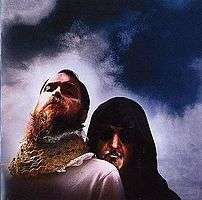Coil
Coil may refer to:
Science, technology and medicine
Music
Other uses
People with the surname
See also

Coil (band)
Coil was an English cross-genre, experimental music group formed in 1982 by John Balance—later credited as "Jhonn Balance"—and his life partner and collaborator Peter Christopherson, aka "Sleazy". The duo worked together on a series of releases before Balance chose the name Coil, which he claimed to be inspired by the omnipresence of the coil's shape in nature. Today, Coil remains one of the most influential and best-known industrial music groups.
The group's first official release as Coil was a 1984 12" album titled How to Destroy Angels released on the Belgian Les Disques du Crépuscule's sublabel LAYLAH Antirecords. Following the 12"s success, Some Bizarre Records produced two albums, Scatology, Horse Rotorvator and Coil departed SomeBizzare Label and Produced Love's Secret Domain, which met with little commercial success, but were praised as innovative due to their blend of industrial music and acid house.
In 1985, the group began working on a series of soundtracks, amongst them music for the first Hellraiser movie based on the novel The Hellbound Heart by their acquaintance at that time, Clive Barker. The group's first live performance in 16 years occurred in 1999, and began a series of mini-tours that would last until 2004. Following the death of John Balance on 13 November 2004, Christopherson announced via their official record label website Threshold House that Coil as an entity had ceased to exist.

Electromagnetic coil
An electromagnetic coil is an electrical conductor such as a wire in the shape of a coil, spiral or helix. Electromagnetic coils are used in electrical engineering, in applications where electric currents interact with magnetic fields, in devices such as inductors, electromagnets, transformers, and sensor coils. Either an electric current is passed through the wire of the coil to generate a magnetic field, or conversely an external time-varying magnetic field through the interior of the coil generates an EMF (voltage) in the conductor.
A current through any conductor creates a circular magnetic field around the conductor due to Ampere's law. The advantage of using the coil shape is that it increases the strength of magnetic field produced by a given current. The magnetic fields generated by the separate turns of wire all pass through the center of the coil and add (superpose) to produce a strong field there. The more turns of wire, the stronger the field produced. Conversely, a changing external magnetic flux induces a voltage in a conductor such as a wire, due to Faraday's law of induction. The induced voltage can be increased by winding the wire into a coil, because the field lines intersect the circuit multiple times.
Rest
Rest may refer to:
Rest may also refer to:
- Rest (cue sports) or mechanical bridge, a device supporting a cue stick on long shots in snooker, billiards and pool games
- Arm rest
- Head rest
- Footrest
- Leg rest
REST written as an abbreviation may refer to:

Rest (album)
Rest, released April 1, 2008, is the second full-length album by Virginian post-rock band Gregor Samsa. The band posted the tracks online at Imeem before the album was released. The album was released in five formats, digital (April 1), unlimited (May 13), limited (April 24), collector's, and vinyl.
Track listing
Contributors

Rest (music)
A rest is an interval of silence in a piece of music, marked by a symbol indicating the length of the pause. Each rest symbol corresponds with a particular note value:
The quarter (crotchet) rest ![]() may also be found as a form
may also be found as a form ![]() in older music.
in older music.
(The four-measure rest or longa rest is a symbol found in Western musical notation denoting a silence four times the duration of a whole rest. They are only used in long silent passages which are not divided into bars.
The two-measure rest or breve rest is another symbol found in Western musical notation denoting a silence twice the duration of a whole rest.
The combination of rests used to mark a pause follows the same rules as for notes. For more details see note value.
One-bar rests
When an entire bar is devoid of notes, a whole (semibreve) rest is used, regardless of the actual time signature. The only exceptions are for a 4/2 time signature (four half notes per bar), when a double whole rest is typically used for a bar's rest, and for time signatures shorter than 3/16, when a rest of the actual measure length would be used. For a 4/2 bar rest, it is also common to use the whole rest instead of the double whole rest, so that a whole-bar rest for all time signatures starting from 3/16 is notated using a whole note rest. Some published (usually earlier) music places the numeral "1" above the rest to confirm the extent of the rest.

